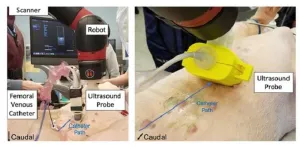(Press-News.org) Intratumoral therapy – in which cancer drugs are injected directly into tumors – is a promising treatment option for solid cancers but has shown limited success in clinical trials due to an inability to precisely deliver the drug and because most immunotherapies quickly dissipate from the site of injection. A team of researchers from Mass General Brigham, in collaboration with colleagues at the Koch Institute for Integrative Cancer Research, has developed a gel delivery system that overcomes these challenges. The gel is injectable but solidifies upon delivery; contains an imaging agent for visualization under CT scan; and can hold a high concentration of drug for slow, controlled release.
In a paper published in Advanced Healthcare Materials, the team reports that using gel-delivered imiquimod (an immune stimulating drug) in combination with checkpoint inhibitor therapy induced tumor regression and increased survival in mouse models of colon and breast cancer that are usually resistant to checkpoint inhibitor therapy. The treatment also appeared to train the immune system to detect and attack distant tumors that were not directly treated, suggesting that it might be a helpful therapy for metastatic cancers.
“This gel tackles the two problems with existing attempts at making intratumoral cancer immunotherapy: making the therapy visible and practical so that interventional radiologists can confirm delivery, and making sure the drug actually stays in the region of interest,” said Avik Som, MD, PhD, of the Department of Radiology at Massachusetts General Hospital, a founding member of the Mass General Brigham healthcare system. “When we inject this gel into a tumor, we're able to teach the immune system to recognize the cancer and trigger it to attack not only the site where the gel was injected, but also other areas in the body where the same cancer may be hiding.”
The research team, which consisted of both engineers and medical professionals, first developed and optimized the gel-delivery system in the lab by tweaking the gel’s chemical structure. One key aspect of the gel’s design was that it needed to shift from being liquid at room temperature to make it injectable but become solid at body temperature inside the tumor in order to form a drug-releasing depot, while also retaining drug encapsulation and delivery capability, and carrying sufficient imaging agent.
After optimizing the gel in the lab, the team tested its ability to treat mouse models of colon and breast cancer that are usually resistant to immunotherapy. To do this, they used the gel to deliver imiquimod, an FDA-approved immune stimulating drug, in combination with checkpoint inhibitor therapy. Each mouse had two tumors of the same type, but the researchers only treated one tumor per mouse, which allowed them to test the gel’s ability to stimulate both local and systemic immunity.
They showed that treating with gel-delivered imiquimod in combination with checkpoint inhibitor therapy improved survival in both cancer models. The treatment resulted in an all-or-nothing response — mice that responded to the treatment showed complete regression of both the treated tumor and a distantly located tumor (a model for metastasis), while non-responders showed no regression at either site. For the colon cancer model, 46% (6/13) survived when the checkpoint inhibitor therapy was combined with gel-delivered imiquimod. For the breast cancer model, 20% (3/15) survived when treated with the combined therapies.
“These two tumors remain challenging to treat today, even though immunotherapies are transforming how we think about treatment,” said co-corresponding author Giovanni Traverso, MB, PhD, MBBCH, Department of Medicine at Brigham and Women’s Hospital, a founding member of the Mass General Brigham healthcare system and an associate professor in the Department of Mechanical Engineering at MIT. “The fact that we were able to induce responses in distant tumors in these colon and breast cancer models was a big win.”
The researchers are keen to move this technology to the clinic, but it will first need to go through more rounds of testing for safety. They also plan to test its efficacy with a broader panel of drugs.
“This is an early proof of concept, but we’re all actively working together to try and get these technologies to patients,” said Eric Wehrenberg-Klee, MD, assistant radiologist in the Department of Radiology at Massachusetts General Hospital and one of the study’s first authors. “There's quite a bit of benefit to be gained by being able to treat patients with a single injection, and we think this technology has the potential to help with cancers that are currently challenging to treat.”
Authorship: Authors include Jan-Georg Rosenboom (MGH, BWH, MIT), Alana Chandler (MIT), Gabrielle Ndakwah (BWH, MIT), Eric Chen (MIT), Jack Suggs (MIT), Joshua Morimoto (MIT), Jonathan Kim (MGH), Abdul Rehman Mustafa (MGH), Asier Marcos-Vidal (MGH), Florian J. Fintelmann (MGH), Arijit Basu (MIT), Robert Langer (MIT), and Umar Mahmood (MGH).
Disclosures: AS, EW, JR, CGT, UM, RL are co-inventors on a patent application describing the Imigel system. AS is a founder of CareSignal, a digital health company, now Lightbeam Health and receives consultancy fees from Boston Scientific. EW receives consultancy fees from Boston Scientific.
Funding: Funding for this study was provided in part by a Boston Scientific Grant (EW), the Philips RSNA Research award (AS), a Deshpande Center grant (AS, JR, GT), a Koch Institute Ludwig Center postdoctoral grant, and Schlaeger Award (AS). UM and EWK are cofounders, shareholders, and consultants (Scientific Advisory Board) of CytoSite BioPharma. All other authors declare they have no competing interests.
Paper cited: Som, A,Rosenboom, J-G, Wehrenberg-Klee, E, et al. “Percutaneous Intratumoral Immunoadjuvant Gel Increases the Abscopal Effect of Cryoablation for Checkpoint inhibitor Resistant Cancer” Advanced Healthcare Materials DOI: 10.1002/adhm.202301848
###
About Mass General Brigham
Mass General Brigham is an integrated academic health care system, uniting great minds to solve the hardest problems in medicine for our communities and the world. Mass General Brigham connects a full continuum of care across a system of academic medical centers, community and specialty hospitals, a health insurance plan, physician networks, community health centers, home care, and long-term care services. Mass General Brigham is a nonprofit organization committed to patient care, research, teaching, and service to the community. In addition, Mass General Brigham is one of the nation’s leading biomedical research organizations with several Harvard Medical School teaching hospitals. For more information, please visit massgeneralbrigham.org.
END
Cardiovascular diseases rank among the top causes of death across the world, and cardiac interventions are similarly very common. For example, cardiac catheter ablation procedures, which are used to treat arrythmias, number in several tens of thousands per year in the US alone. In these procedures, surgeons insert a thin, flexible tube called a catheter into the femoral vein in the leg and navigate their way up to the heart, where the problematic tissue is destroyed using cold or focused radiation.
Even though cardiac catheter-based procedures are considered minimally invasive, the position ...
A team of engineers from the University of Illinois has published the first known study documenting the long-jumping motion of 3D-printed insect-scale robots.
The new study, published in the journal Smart Materials and Structures, follows a previous publication that documented the same lab’s investigation of vertical jumping in insect-scale robots. The study is led by Professor Sameh Tawfick, an associate professor and Ralph A. Andersen Faculty Scholar in the Department of Mechanical Science and Engineering. His lab, the Kinetic Materials Research Group, studies the ...
University of Maryland researchers aiming to combat rising global temperatures have developed a new “cooling glass” that can turn down the heat indoors without electricity by drawing on the cold depths of space.
The new technology, a microporous glass coating described in a paper published in the journal Science, can lower the temperature of the material beneath it by 3.5 degrees Celsius at noon, and has the potential to reduce a mid-rise apartment building’s yearly carbon emissions by 10%, according to the research team led by Distinguished University Professor Liangbing Hu in the Department of Materials ...
Optica, an international association in optics and photonics, recently announced the election of University of Oklahoma engineering professor Javier Jo, Ph.D., as a Fellow member.
Jo, a faculty member in the School of Electrical and Computer Engineering, was honored for his contributions to integrating optical imaging and artificial intelligence for biomedical applications. His research focuses on developing optical sensing and imaging technologies to understand pathophysiological mechanisms in human diseases and improve their clinical management.
“Dr. Jo’s ...
From ChatGPT to DALL-E, deep learning artificial intelligence (AI) algorithms are being applied to an ever-growing range of fields. A new study from University of Toronto Engineering researchers, published in Nature Communications, suggests that one of the fundamental assumptions of deep learning models — that they require enormous amounts of training data — may not be as solid as once thought.
Professor Jason Hattrick-Simpers and his team are focused on the design of next-generation materials, from catalysts that convert captured carbon into fuels to non-stick surfaces that keep airplane wings ice-free.
One ...
Annals of Internal Medicine Tip Sheet
@Annalsofim
Below please find summaries of new articles that will be published in the next issue of Annals of Internal Medicine. The summaries are not intended to substitute for the full articles as a source of information. This information is under strict embargo and by taking it into possession, media representatives are committing to the terms of the embargo not only on their own behalf, but also on behalf of the organization they represent.
----------------------------
1. Acupuncture may offer limited relief to patients with chronic hives
Abstract: https://www.acpjournals.org/doi/10.7326/M23-1043
Editorial: ...
Embargoed for release until 5:00 p.m. ET on Monday 13 November 2023
Annals of Internal Medicine Tip Sheet
@Annalsofim
Below please find summaries of new articles that will be published in the next issue of Annals of Internal Medicine. The summaries are not intended to substitute for the full articles as a source of information. This information is under strict embargo and by taking it into possession, media representatives are committing to the terms of the embargo not only on their own behalf, but also on behalf ...
A new study by investigators from Mass General Brigham found that one in five individuals taking Nirmatrelvir-ritonavir therapy, commonly known as Paxlovid, to treat severe symptoms of COVID-19, experienced a positive test result and shedding of live and potentially contagious virus following an initial recovery and negative test—a phenomenon known as virologic rebound. By contrast, people not taking Paxlovid only experienced rebound about 2 percent of the time. Results are published in Annals of Internal Medicine.
“We conducted this study to address lingering questions about Paxlovid and virologic rebound in COVID-19 treatment,” said corresponding ...
JUPITER, Fla. — Slumbering among thousands of bacterial strains in a collection of natural specimens at The Herbert Wertheim UF Scripps Institute for Biomedical Innovation & Technology, several fragile vials held something unexpected, and possibly very useful.
Writing in the journal Nature Chemical Biology, a team led by chemist Ben Shen, Ph.D., described discovery of two new enzymes, ones with uniquely useful properties that could help in the fight against human diseases including cancer. The discovery, published ...
New York, NY (November 13, 2023)—Researchers at the Mount Sinai Center for Transformative Disease Modeling have released a groundbreaking study identifying 4,749 key gene clusters, termed “prognostic modules,” that significantly influence the progression of 32 different types of cancer. The study, published in Genome Research, serves as a comprehensive resource and lays the foundation for the development of next-generation cancer treatments and diagnostic markers.
Despite significant progress in cancer research, understanding the disease's genetic intricacies ...




